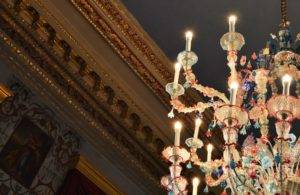Castletown’s Long Gallery is famous for its set of three Venetian chandeliers, believed to have been ordered by Lady Louisa Conolly when she was refurbishing the room in the 1770s. The chandeliers are unique in Ireland, and thought to be associated with the studio of glass maker Giuseppe Lorenzo Briati at Murano. They are important in the history of eighteenth century Venetian glass and are the only set of this kind known to have survived from the period. A similar but smaller chandelier hangs in the Palazzo Mocenigo in Venice.
Over the years, losses and breakages resulted in makeshift repairs and ad hoc replacement of pieces. Electrification of the chandeliers in the 1960s caused structural problems, and misalignment of the metal armature caused sagging and distortion. Layers of dust needed to be cleaned away.
Restoration of the chandeliers began in 2009. With the help of counterparts in the Commune di Venezia, OPW senior conservation architect John Cahill identified skilled specialists to survey and assess the chandeliers and carry out the restoration works. Conservation consultant Susan Corr oversaw the project, and craftsmen from Galliano Ferro of Murano provided historical continuity with their traditional expertise, working on the restoration and making replacement pieces where necessary.
The goal was to make the chandeliers safe and secure, returning them to their original condition in so far as possible. The work was done in situ over two months and since then the chandeliers have been a major highlight for visitors, and a wonderful backdrop for musical events in the Long Gallery.

Glass and wood elements were analysed and recorded during the conservation process. All the original parts of the chandeliers were identified and retained, and broken pieces were reused in non-load-bearing positions. Later additions were also retained provided they were handmade. Commercially made additions were recorded and removed.

In order to position newly made pieces, the arrangement of the decorative elements had to be reinterpreted according to the traditional assemblage of such chandeliers, and it was agreed that missing parts would be replaced with new handmade pieces from Murano in Venice. These included some of the flowers, leaves, grapes and finials. The original glass manufacturer in Murano is no longer operating, but it was possible to source a firm that continues in the same tradition of glass making, using traditional methods, designs, and pigments.
Text by Deirdre Cullen



